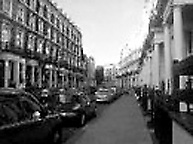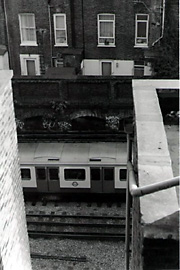 Hogarth Road in Earl's Court
Hogarth Road in Earl's Court
My bedroom was quaint but bright like the living room. A window with a tiny ledge looked out to a hotel across the way whose windows were decorated with flower beds and small twinkling white lights. This was my living quarters when I was a Missouri State University study-away student living for a semester in Earl's Court, a cozy neighborhood in the heart of London.
Dana Carroll, who heads the Missouri-London study-away program at Missouri State, says the program has housed students in Earl's Court for the 12 years she has worked for the program.
It’s easy to see why. Earl's Court offers everything imaginable within a radius of a few miles. The neighborhood is filled with low-cost clothing shops, grocery stores, libraries, pubs, night clubs, lush parks and the bustling tube station.
Carroll points out that the neighborhood is a good choice because it is close to area attractions such as Harrods, the Natural History Museum and Kensington Palace as well as being within a 20-minute walk of Missouri State's campus host, Imperial College.
Sally Ebest, an English professor at the University of Missouri-St. Louis, says she enjoyed the convenience of living in Earl's Court when she taught abroad at Imperial College in 2004 but spoke of its drawbacks.
“I liked Earl's Court because everything you wanted was within walking distance: the tube, groceries, coffee shops, wine bars, Thai and Indian food, the post office, banks, ATMs, a bakery, a newsstand, McDonalds, a pharmacy and Oxfam,” she says. “On the other hand, all of these food places coupled with recent work on the tube and fear of the IRA putting bombs into trash cans meant that trash and rubbish were piled in the streets...and the rats ran wild, at least outside my flat.”
In fact, Ebest commented that the rats that congregated around her basement flat were as big as her cat and that their screeches would wake her up.
Train approaching

The tube station usually was filled with madness: pigeons flying, babies crying, people shoving into one another and omnipresent musicians playing bizarre instruments that all blended together to create a loud buzzing. Musicians practiced busking, or playing music for donations, a common practice for artists in London made legal at certain tube stations in the summer of 2005.
Tiny half-doors would open with the swipe of a pass, also known as an Oyster card, and people climbed down steep stairs to the area where the trains arrived. The waiting area had the distinct smell of gasoline and body odor. At dinnertime, large crowds of business people would rush on to the train.
“Train approaching,” an overhead sign would flash when a train was about to arrive.
“Mind the gap,” the train operator would announce in his British accent. Each time I rode the tube, I stepped carefully over the huge space between the train and the platform, better known in Britain as the gap.
“Doors closing. Doors closing,” the announcer said. “This train is ready to depart.”
The tube stops near Earl's Court offered many forms of entertainment. Kensington High Street is still among the most popular stops. That area is filled with clothing shops like H & M, Top Shop and Gap. I often lost myself in passing conversation, colorful window displays, and ten-for-a-pound postcard stands as I barreled through the crowds of Saturday shoppers.
When I was tired of the bustle of city life, I retreated to London’s largest haven for relaxation: Hyde Park. The cool, vivid grass is considered the perfect lounging spot for any Londoner. Even men in their business suits could be found napping in the shadows of the park on their lunch breaks.
Linda Pettijohn, a Missouri State professor who taught international marketing in London during the fall of 2005, says she spent a lot of time in the London parks.
“I think about the parks every day,” she says. “I miss the statues, the people from around the world, the palace, the vendors, the lakes, the birds.”
Carroll says she also enjoyed Hyde Park during a prior visit.
“The times I’ve walked there, she said, I saw uniformed nannies pushing baby carriages the size of small compact cars, people lolling on the grass, and men playing what appeared, to my unseasoned eyes, to be rugby.”
After a long day in London, I was comforted after returning to my flat. Some nights, the sound of the soft London rain tapping on my window lulled me to sleep. Other nights, I crawled into my bunk bed and fell asleep to the swooshing sound of the tube as it shuffled in and out of the nearby tunnel. But no matter what sound I heard, no matter how far away I was from family and friends, Earl's Court always felt like home.






Comments